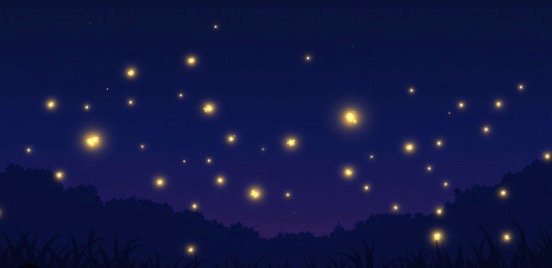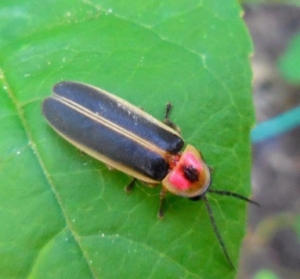SCORES & OUTDOORS: Are fireflies making a comeback? Seeing more this year than past summers
 by Roland D. Hallee
by Roland D. Hallee
A little while back someone inquired about fireflies and how they have been scarce as of late. Well, the other night, my wife and I were treated with a light show like we have not seen in a while. We were sitting enjoying the warm summer night when the area to our right became lighted up with dozens of them.
Fireflies are soft-bodied beetles commonly called fireflies, lightning bugs, or glowworms for their conspicuous production of light, mainly during twilight, to attract mates. Light production is thought to have originated as a warning signal the larvae were distasteful. This ability to create light was then co-opted as a mating signal and, in a further development, adult female fireflies mimic the flash pattern of the Photinus beetle to trap their males as prey.
Fireflies are found in temperate and tropical climates. Many live in marshes or in wet, wooded areas where their larvae have abundant sources of food. Although all known fireflies glow as larvae, only some species produce light in their adult stage, and the location of the light organ varies among species and between sexes of the same species. Fireflies have attracted human attention since classical antiquity; their presence has been taken to signify a wide variety of conditions in different cultures and is especially appreciated aesthetically in Japan, where parks are set aside for this specific purpose.
Fireflies are beetles and in many aspects resemble other beetles at all stages of their life cycle, undergoing complete metamorphosis. A few days after mating, a female lays her fertilized eggs on or just below the surface of the ground. The eggs hatch three to four weeks later.
The larvae feed until the end of the summer. Most fireflies hibernate as larvae. Some do this by burrowing underground, while others find places on or under the bark of trees. They emerge in the spring. The larvae of most species are specialized predators and feed on other larvae, terrestrial snails, and slugs. Some are so specialized they have grooved mandibles that deliver digestive fluids directly to their prey. The larval stage lasts from several weeks up to, in certain species, two or more years. The larvae pupate for one to two-and-a-half weeks and emerge as adults.
Light production in fireflies is due to the chemical process of bioluminescence. This occurs in specialized light-emitting organs, usually on a female firefly’s lower abdomen. Adults emit light primarily for mate selection.
Many fireflies do not produce light. Usually these species are diurnal, or day-flying. A few diurnal fireflies that inhabit primarily shadowy places, such as beneath tall plants or trees, are luminescent.
Like Fourth-of-July fireworks, cool swims on hot days, and lazy vacations, fireflies are a sign of summer. Many of us have cherished memories of spotting and catching them during warm summer evenings and running through fields that sparkled as if strewn with stars. But there are signs our
kids may not grow up with the same firefly memories we had. That’s because fireflies are disappearing from marshes, fields and forests all over the country – and all over the world. And if it continues, fireflies may fade forever, leaving our summer nights a little darker and less magical.
Why Are Fireflies Disappearing? Nobody knows for sure. But most researchers blame two main factors: development and light pollution.
Most species of fireflies thrive as larvae in rotting wood and forest litter at the margins of ponds and streams. And as they grow, they more or less stay where they were born. Some species are more aquatic than others, and a few are found in more arid areas—but most are found in fields, forests and marshes. Their environment of choice is warm, humid and near standing water of some kind—ponds, streams and rivers, or even shallow depressions that retain water longer than the surrounding ground.
The problem is that in America and throughout the world, our open fields and forests are being paved over, and our waterways are seeing more development and noisy boat traffic. As their habitat disappears under housing and commercial developments, firefly numbers dwindle. Logging, pollution and increased use of pesticides may also contribute to destroying firefly habitat and natural prey.
The next time you see a firefly, thank it for the memories, and hopefully the next generation will also be able to enjoy them.
* * * * * *
Regarding Scores & Outdoors column on Japanese Beetles in the July 10, 2025, issue of The Town Line.
Thank you for writing about Japanese beetles and warning folks not to use traps. Just this morning I was knocking them into a #10 can of water topped with a few drops of dish detergent. It keeps them from flying out of the can, then I strain then out for our ducks as a special treat. I discovered that the small Viriginia creeper vine on the north fence of our vegetable garden is attracting them away from the asparagus bed and other plants making them easier to catch. I now have what the Integrated Pest Management folks call trap cropping. I casually planted some zinnias in my community garden bed which is having the same effect – my flowers aren’t pretty, but the Japanese beetles are feasting there instead of the other’s folk’s plants.
Roland’s trivia question of the week:
Who was the last Boston Red Sox player to be named Most Valuable Player in the World Series?
Responsible journalism is hard work!
It is also expensive!
If you enjoy reading The Town Line and the good news we bring you each week, would you consider a donation to help us continue the work we’re doing?
The Town Line is a 501(c)(3) nonprofit private foundation, and all donations are tax deductible under the Internal Revenue Service code.
To help, please visit our online donation page or mail a check payable to The Town Line, PO Box 89, South China, ME 04358. Your contribution is appreciated!




Leave a Reply
Want to join the discussion?Feel free to contribute!